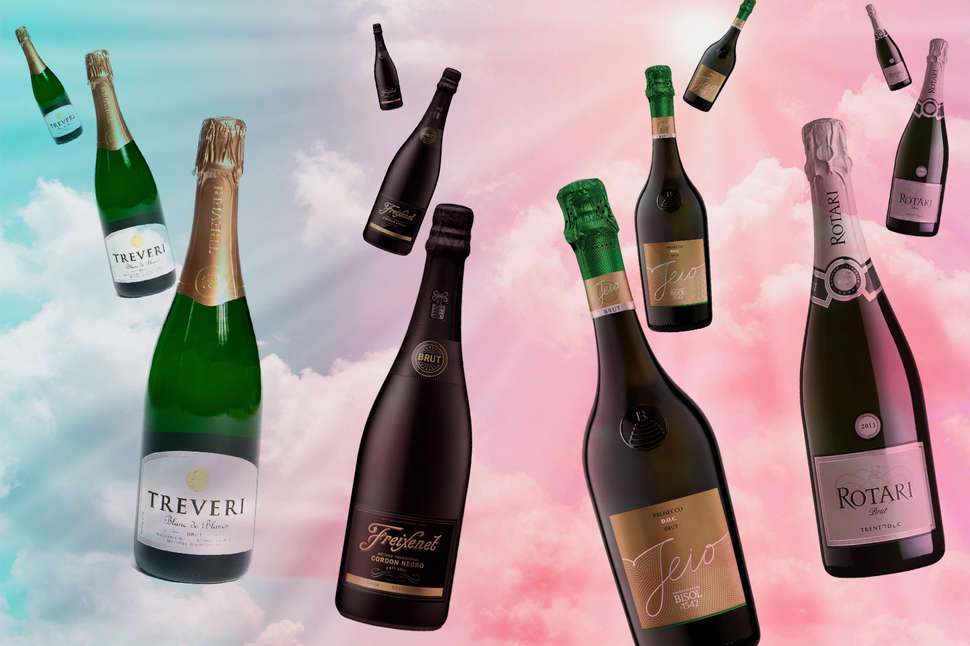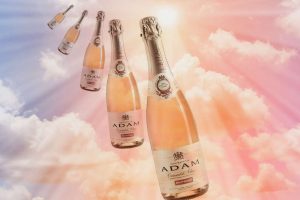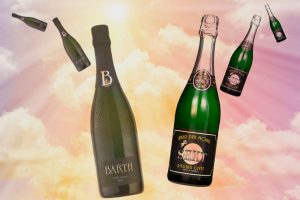Portfolio
Sparkling Wines You Should Be Drinking Right Now (That Aren’t Champagne)

For centuries, sparkling wine has been synonymous with celebration. From the royal courts in 18th century France, to your cousin’s wedding, midnight on New Year’s Eve, and other life milestones, someone, somewhere was definitely shouting, “pop the Champagne!”
The bubbles are flowing, however not all rectangles are squares. Champagne is often incorrectly used as a blanket term for the category of sparkling wine — but simply put, Champagne is a wine region, not a style of wine. “As WWI came to a close, the French decided to protect the use of the term ‘Champagne’ on wine labels so that it could only refer to bubbly made in the traditional Méthode Champenoise (Traditional Method) from grapes both grown and vinified in the Champagne region of France,” explains Brian Smith, Co-founder and Chief Wine Officer of Winc. From growing to harvesting and processing the grapes (usually Pinot Noir, Pinot Meunier, Chardonnay), the Appellation standards are rigorous, yielding a luxe libation with a hefty price tag.
But Champagne aside, the sparkling wine market has been increasing for decades; just last year, the Wine Institute reported an 8 percent increase in America’s bubbly consumption year-over-year. “I’m a firm believer that enjoying sparkling wine shouldn’t be an act reserved only for holidays or large milestones,” says Smith. “An increasing excitement among younger consumers towards sparkling wines proves that they’re more keen to trying different bubbles over Champagne.”
So while Drake is living his Champagne Bottle Life, us common folk with budgets can be doing the same thing, but with the world’s other delicious sparkling wine options that will put us in the merry-making spirit without our credit cards bursting into flames. Let’s raise a toast to these bubblies perfect for popping immediately.
Prosecco
In layman’s terms, Prosecco is from Italy (the Veneto region) and made with Glera grapes. In lieu of traditional production methods, Prosecco utilizes a more-affordable Tank Method, where lower pressure during the carbonation process creates lighter, spritzier bubbles. Prosecco’s flavor profile is fruitier than Champagne’s, featuring green apple, honeydew, honeysuckle, and pear — so if you’re looking to whip up some poolside mimosas or bellinis, Prosecco it is, because the flavors won’t butt heads with added spirits and mixers.
Bisol Jeio Prosecco DOC Brut ($18): Bisol’s grapes are grown on the hilliest plots in the Valdobbiadene, Prosecco region; a unique terroir that yields a dynamic sparkling wine with intense-yet-pleasant citrus notes and a subtle saltiness. This refreshing bubbly is perfect for literally any wine drinker — serve it for sippin’ at a cocktail party, or with a flaky fish dinner, like halibut topped with spicy mango salsa.
Santa Margherita Prosecco Superiore DOCG ($27.99): Across the board, the Santa Margherita portfolio is a recognizable crowd-pleaser. Their Prosecco has DOCG status (the highest classification), with extra-fine bubbles, a pleasantly fruity aroma, and well-balanced flavor. Sure, it’s slightly higher priced than some Proseccos, but you’re paying for both name and quality — so bring a bottle as a housewarming gift for guaranteed friendship brownie points.
Cava
A round of applause to Spain for endowing the world with Cava — a sparkling wine from Catalonia crafted for those with a Krug taste on a plebian’s budget. Cava is made with three local grapes you’ve probably never heard of (Macabeo, Xarel-lo and Parellada) and produced using Champagne’s Traditional Method, yet a delicious bottle will run you under $15. Cava greets your palette with balanced notes citrus, melon, pear, a pleasant acidity, and sometimes a touch of earthiness.
Anna de Codorniu Brut Rosé ($14.99): Yes, you can buy elegance for under $15. Over 25 years ago, Anna de Codorniu became the first Cava to use the Chardonnay varietal in its cuvée (high-quality batch); their so-smooth-it’s-creamy rosé Cava is 30% Chardonnay, with the 70% Pinot Noir giving it a red-fruit aroma and color. Now, up your brunch game: pop a (chilled) bottle, skip the OJ, and pair it with any style eggs.
Freixenet Sparkling Cordon Negro Brut Cava ($12): Here’s one of the best-selling Cavas out there, and for good reasons: it’s deliciously fresh and a bottle costs less than a single cocktail in Manhattan. Made with the region’s three most dominant grapes, you’ll taste fresh citrus flavors upfront with a toasted almond aroma. With flawless acidity and balance, this medium-bodied sparkling pairs well with just about anything — from risotto and grilled artichoke, to “my in-laws are here, open that third bottle.”
American Sparkling
When you think of American sparkling wine, you probably picture yourself sipping bubbles in the vineyards of Napa and Sonoma (…can I come?). You wouldn’t be off track: many of California’s most famous wineries were set up by OGs in the Champagne world, including Domaine Chandon (Moet et Chandon), Roederer Estate (Louis Roederer), and Domaine Carneros (Taittinger). (Note: Before Champagne restrictions were placed, certain domestic producers had already been labeling their product as California Champagne; they were grandfathered in and are still allowed to label their wines as such.)
And so, the desire for domestic bubbly grew, and continues to do so. But beyond the Golden State, wine regions in Oregon, Washington, and New York’s Finger Lakes are also flourishing, bottling tons of the fizzy stuff made with Riesling, Chardonnay, Pinot Noir, Pinot Blanc, and other grapes that thrive in cooler climates.
Farmstead Long Meadow Ranch Brut ($32): With aromas of apple, pear, and citrus plus floral and spice notes, this structured Sonoma County sparkling is made in the Traditional Method and then aged in the bottle for 18 months. It’s affordable, but still elegant and steps above Netflix-and-Chill, so pop the cork and have yourself a night (plus-one optional): enjoy it with oysters and caviar or a fruit and cheese board.
Treveri Cellars Gerürztraminer ($18.99): This wine house nestled in Columbia Valley, Washington uses the Traditional Method to make sparklers from various varietals; and this fizzy features the Gewürztraminer grape, which is slightly zippy with mild fruit aromas and the perfect touch of sweetness ($3.5% sugar). Use it as a base for a festive wine spritzers, or pair it with spicy Thai takeout and reruns of Curb Your Enthusiasm.
Finke’s Sparkling White Blend 2017 ($16): You and this California sparkling wine from Winc’s portfolio have something in common: you’re both ready to drink immediately. Bottled six months after harvest, this youthful blend of Chenin Blanc and Chardonnay was made by harvesting the grapes early in the season using Charmat Method. The result: a fresh, crisp, effervescent bubbly that’s dry on the palette with tropical fruit notes. Thus, it bodes well light, salty foods like sushi, fish, and cured meats.
Trentodoc
Meet Trentodoc: Italy’s highest altitude sparkling wine from the northeast Dolomite Mountains (a UNESCO World Heritage Site). Its vines grow mostly Chardonnay and Pinot Nero varietals at at around 3,280 feet sea level; these elevations combined with limestone-based soil give the final wine a mineraly freshness, delightful acidity, noteable fragrance, and a fuller body than Prosecco. All Trentodoc bubbly has been made using the Classic Method for 150 years; they’re also one of the world’s first officially recognized “Metodo Classico” wines, meaning the wine undergoes in-bottle refermentation and ages a minimum of 15 months.
Trentodoc Altemasi Brut ($24): This sparkling is made with 100% Chardonnay grapes that are grown at about 1,476 feet-2,000 feet above sea level. It’s full-bodied on the palette yet exceptionally crisp. Impress your friends by taking a sip and commenting on its fine perlage (aka, small, tight bubbles), then serve it with salmon steak or seafood paella.
Rotari Brut ($16): Also made with 100% Chardonnay, this Trentodoc displays a rich flavor, strong fruity bouquet, and pleasant yeasty notes — results of the mountains’ unique and strong climate changes. It’s full-bodied, vicious, and Italian — so there is no better pairing than a glass of this stuff with spaghetti and tomato sauce.
French Sparkling Crémant
Champagne aside, France is home to 22 other sparkling wine regions (oh, the imbibing possibilities!) Eight of these regions — including Burgundy, Alsace, and the Loire Valley, who are already well-known for their still reds and whites — have been on-the-DL producing delicious Crémants using the Traditional Method with their local varietals, giving each sparkling its own unique character (and more reasonable price tag). Okay, so a bottle of Champagne will still generally outlive a good quality Crémant in storage — but that’s all the more reason to get drinking and enjoy it now!
NV Jean-Baptiste Adam Brut Rosé ($21): This Crémant d’Alsace comes from the Alsace wine region, which produces over 50% of France’s Crémants; its sunny, warm microclimate with minimal rainfall allows the grapes to ripen gradually, making for dry and aromatic wine. It’s made with 100% Pinot Noir (all rosé bubbles from this Appellation are) and you’ll taste zingy currant and succulent strawberries.
Leveret Freres Crémant de Bourgogne Brut ($17.99): Chardonnay, Pinot Noir, and Gamay — this is a fizzy blend of Burgundy’s best. It’s a dry, medium-bodied Crémant that’s fresh and and lemony, a touch toasty, and offers white floral aromas. This bubbly is just like your girlfriend: simply elegant, yet complex at the same time. And that’s why you love her! Enjoy as an aperitif or as a companion to puff pastry dessert.
German Sekt
We all know that Germany gets an A+ in brewing beer, but they also have unsung skills in making Sekt (aka, sparkling wine). In fact, Germans are largest consumers of bubbly in the world — and that’s because they make damn delicious sparkling that mostly stayed within German borders until semi-recently. Now that German Sekt has shed its mediocre reputation, the good stuff can be found in specialty American wine shops, and the sip is worth the trip: Sekt is primarily Riesling-based, which offers a naturally refreshing balance of ripeness, acidity, and frutiness.
Over The Moon Riesling Sekt ($18.95): Riesling grapes thrive in cooler climates like that of the Rheingau region, where this well-known Sekt producer is based. Their light-bodied, semi-dry bubbly wears its Riesling characteristics on its sleeve, with bright acid and citrus fruit flavors that pair phenomenally with chicken, shellfish, and soft, mild cheeses like Brie.
Barthe Pinot Blanc Sekt Brut ($27.95): A unique Sekt also from Rheingau, it’s made with Pinot Blanc grapes (Pinot Noir’s cousin) using the Traditional Method and aged in yeast for 18-24 months; the result is a vibrant-yet-complex sparkling wine that finishes velvety smooth. Pair with fresh fish and summer veggies to complement its subtly rich flavors (pear, peach skin, roasted nuts, caramel).
Brooke Sager is a contributing writer for Thrillist and an oenophile who believes every day is a celebration deserving of bubbly. Give her a follow on Instagram.
Portfolio> Home>
Client: Thrillist
Date: November 25, 2018
Service: Copywriter


